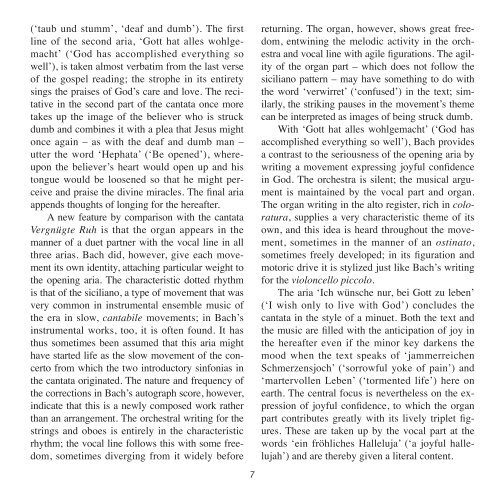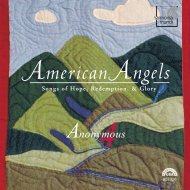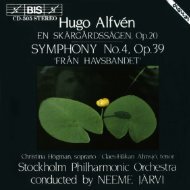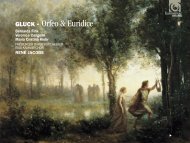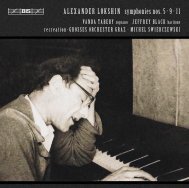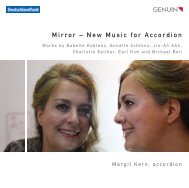Johann Sebastian Bach BACH COLLEGIUM JAPAN ... - eClassical
Johann Sebastian Bach BACH COLLEGIUM JAPAN ... - eClassical
Johann Sebastian Bach BACH COLLEGIUM JAPAN ... - eClassical
Create successful ePaper yourself
Turn your PDF publications into a flip-book with our unique Google optimized e-Paper software.
(‘taub und stumm’, ‘deaf and dumb’). The first<br />
line of the second aria, ‘Gott hat alles wohlge -<br />
macht’ (‘God has accomplished everything so<br />
well’), is taken almost verbatim from the last verse<br />
of the gospel reading; the strophe in its en tirety<br />
sings the praises of God’s care and love. The reci -<br />
tative in the second part of the cantata once more<br />
takes up the image of the believer who is struck<br />
dumb and combines it with a plea that Jesus might<br />
once again – as with the deaf and dumb man –<br />
utter the word ‘Hephata’ (‘Be opened’), where -<br />
upon the believer’s heart would open up and his<br />
tongue would be loosened so that he might per -<br />
ceive and praise the divine miracles. The final aria<br />
appends thoughts of longing for the hereafter.<br />
A new feature by comparison with the cantata<br />
Vergnügte Ruh is that the organ appears in the<br />
manner of a duet partner with the vocal line in all<br />
three arias. <strong>Bach</strong> did, however, give each move -<br />
ment its own identity, attaching particular weight to<br />
the opening aria. The charac ter istic dotted rhythm<br />
is that of the siciliano, a type of movement that was<br />
very common in instru mental ensemble music of<br />
the era in slow, canta bile movements; in <strong>Bach</strong>’s<br />
instrumental works, too, it is often found. It has<br />
thus sometimes been assumed that this aria might<br />
have started life as the slow movement of the con -<br />
certo from which the two introductory sin fonias in<br />
the cantata orig inated. The nature and fre quency of<br />
the correc tions in <strong>Bach</strong>’s autograph score, however,<br />
indicate that this is a newly com posed work rather<br />
than an arrangement. The orch estral writing for the<br />
strings and oboes is entirely in the characteristic<br />
rhythm; the vocal line follows this with some free -<br />
dom, some times diverging from it widely before<br />
7<br />
return ing. The organ, how ever, shows great free -<br />
dom, en twining the melodic activity in the orch -<br />
estra and vocal line with agile figurations. The agil -<br />
ity of the organ part – which does not follow the<br />
sici liano pattern – may have something to do with<br />
the word ‘verwirret’ (‘con fused’) in the text; sim -<br />
ilarly, the striking pauses in the movement’s theme<br />
can be interpreted as images of being struck dumb.<br />
With ‘Gott hat alles wohlgemacht’ (‘God has<br />
accomplished everything so well’), <strong>Bach</strong> provides<br />
a contrast to the seriousness of the opening aria by<br />
writing a movement expressing joyful confidence<br />
in God. The orchestra is silent; the musical argu -<br />
ment is maintained by the vocal part and organ.<br />
The organ writing in the alto register, rich in col o -<br />
ra tura, supplies a very characteristic theme of its<br />
own, and this idea is heard throughout the move -<br />
ment, sometimes in the manner of an ostinato,<br />
sometimes freely developed; in its figuration and<br />
motoric drive it is stylized just like <strong>Bach</strong>’s writing<br />
for the violoncello piccolo.<br />
The aria ‘Ich wünsche nur, bei Gott zu leben’<br />
(‘I wish only to live with God’) concludes the<br />
can tata in the style of a minuet. Both the text and<br />
the music are filled with the anticipation of joy in<br />
the hereafter even if the minor key darkens the<br />
mood when the text speaks of ‘jammerreichen<br />
Schmer zensjoch’ (‘sorrowful yoke of pain’) and<br />
‘mar tervollen Leben’ (‘tormented life’) here on<br />
earth. The central focus is nevertheless on the ex -<br />
pression of joyful confidence, to which the organ<br />
part contributes greatly with its lively triplet fig -<br />
ures. These are taken up by the vocal part at the<br />
words ‘ein fröh liches Halleluja’ (‘a joyful halle -<br />
lujah’) and are thereby given a literal content.


